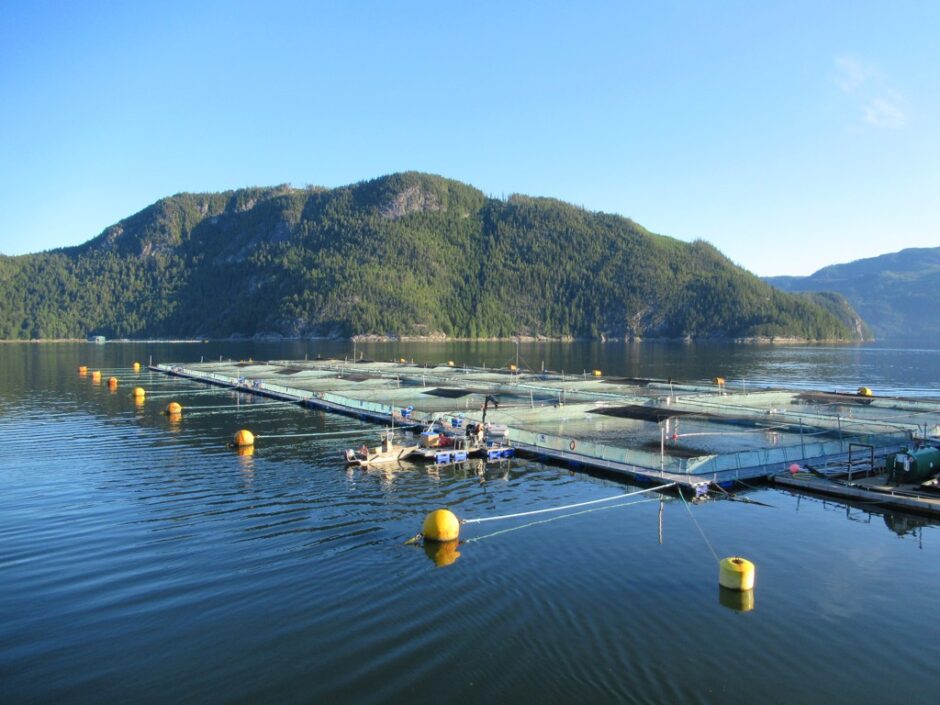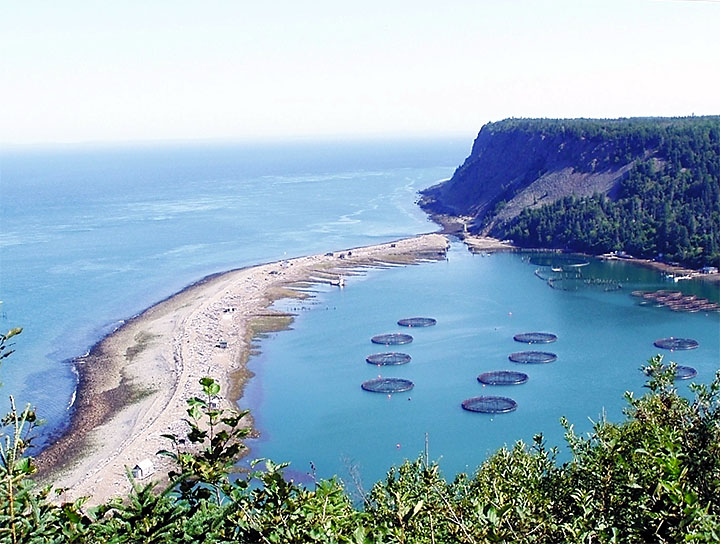Monitoring Impacts of Farmed Salmon Escapes on Wild Salmon Populations
 Grieg Seafood operates a salmon farm in Clio Channel, Broughton Archipelago, British Columbia, Canada, in partnership with the Tlowitsis First Nation. (Credit: David Stanley via Flickr CC 2.0)
Grieg Seafood operates a salmon farm in Clio Channel, Broughton Archipelago, British Columbia, Canada, in partnership with the Tlowitsis First Nation. (Credit: David Stanley via Flickr CC 2.0)While salmon farming is a popular form of aquaculture, equipment failures, storms, and attacks by predators can lead to escapes. Because the farmed salmon differ from native species, researchers continually study escapees to understand their effects on the environment and wild salmon populations.
Due to a lack of large-scale farmed salmon escape research in Newfoundland, Canada’s Department of Fisheries and Oceans (DFO) seized the opportunity in 2013 to study one of the southern coast’s biggest escape events. CBC reports that in Hermitage Bay, twenty thousand farmed salmon escaped from their sea cages, almost equaling the amount of wild salmon in affected rivers.
As the farmed fish began to integrate with wild salmon, Newfoundland DFO research scientist Ian Bradbury was tasked with studying this escape event and others in the area to assess impacts on wild populations and possible future consequences.
Bradbury’s research asks: “What were the chances that those farms’ salmon made it to rivers? And what were the chances they were interbreeding with wild salmon? And what did that mean for these wild populations?”
Genetically Monitoring Wild and Farmed Salmon Populations
Bradbury’s research team detected farmed salmon in wild rivers shortly after the escape event, and many of these recently-escaped salmon were mature and in spawning condition.
The year after the escape, researchers sampled fins from young salmon and genetically tested DNA samples to determine if either parent was farmed.
Bradbury explains, “We go out, and we take a sample of a piece of fin, and we come back to the lab and we screen the DNA of that juvenile salmon. We look at how much of that DNA came from wild or farm salmon. So, in looking at its ancestry, we try to understand how much of a genome was farm versus wild, and what that might mean for the population.”
In the year following the escape event, many of the surveyed rivers contained offspring of the farmed salmon, showing they were especially prevalent around Hermitage Bay.
Researchers continued genetically monitoring salmon populations until 2021, tracking hybrids–offspring of farmed and wild salmon–over time to understand their survival rates. While previous research suggested farmed salmon and hybrids don’t do very well in the wild, the males were able to mature as juveniles, allowing them to participate in spawning events.
“What we’re finding is, the hybrids don’t have to go to sea and come back to reproduce. They can mature in the rivers as juveniles. We’re actually detecting their offspring and showing kind of an echo to the original escape event,” explains Bradbury.
The echo involves hybrids continuing to interbreed, resulting in introgression, which allows researchers to observe the salmon’s genetic changes over multiple generations. Ultimately, the question is: What does this mean for wild salmon in the area?
Bradbury answers, “Wild salmon adapted over the last 10-20 thousand years to local conditions–to the flows, the temperatures, the pathogen, communities–everything that’s in the natural environment.”
Hybrids that inherit more farmed salmon traits aren’t expected to survive as long in the wild due to not undergoing the same years of evolution as their native counterparts. Farmed salmon are aggressively selected to grow fast and get big, allowing them to do well in farms and cage culture but leaving them disadvantaged in the wild.

Dark Harbour, Grand Manan, New Brunswick, Canada. The circular structures are salmon aquaculture pens. (Credit: Evan Gamblin via Wikimedia Commons Public Domain)
Scale of Salmon Interbreeding
While researching the impacts of the 2013 escape event on wild populations in a 2018 study published by Communications Biology, Bradbury and fellow researchers determined, despite some evidence of hybridization, impacts on wild populations are still uncertain.
The study reported a clear association between wild population size and the risks of hybridization. In particular, smaller populations of wild salmon were at a greater risk of hybridization due to a larger representation of farmed salmon.
The proportions of hybrids and introgressed individuals dominated in the smaller populations that Bradbury sampled, while bigger populations didn’t appear to have been changed significantly.
Population Impact Theories
According to Bradbury, although modeling and experimental work suggest escapees can drive a decline in wild salmon associated with the escape events, this link is difficult to make in the field primarily due to a lack of monitoring data.
While researchers in Norway have made links to significant changes due to interbreeding, researchers in Newfoundland continue to theorize and conduct studies examining the evolutionary potential of farmed salmon and hybrids, following assumptions that salmon numbers are decreasing because hybrids’ survival rates are low.
While researchers hypothesize demographic hits following escape events, they also theorize a possible evolutionary legacy that could make future generations more susceptible to impacts like population declines or climate change.
For example, a 2024 review published by Reviews in Fisheries Science & Aquaculture examined a long-term 92% fall of Atlantic salmon in the Conne River in Newfoundland. The reviewers found aquaculture, predation, and climate change to be possible factors of the major decline.
According to these authors, two decades of research across the North Atlantic suggest hybridization and introgression could result in the wild salmon population’s genetic alteration and, in some cases, declines.
Conclusion
There are likely several factors contributing to the decline of salmon populations across its range. In regions where wild salmon and salmon aquaculture co-exist, decades of research suggest negative interactions occur with uncertain short-term and long-term consequences.
Canada has recently evaluated the risk of potential impacts of escaped farm salmon and their genetic impacts on wild salmon and concluded significant demographic and genetic impacts are likely in the 2023 Science Advisory Report.
In the report, researchers suggested that evolutionary potential, like a species’ ability to respond to climate change, could be impacted by a change in the evolutionary process. Ongoing work is examining the interaction between climate change and interbreeding with farmed salmon, specifically asking what that means for the wild populations and their ability to respond to climate change.
By examining the thermal tolerance of wild, farmed, and hybrid salmon the work is exploring what these changes could mean for climate change impacts.
As escape events continue to occur, Bradbury and his team track and analyze farmed salmon’s effects on the genetics and population sizes of wild salmon, as well as closely assessing other potential risks associated with the escape events.


0 comments